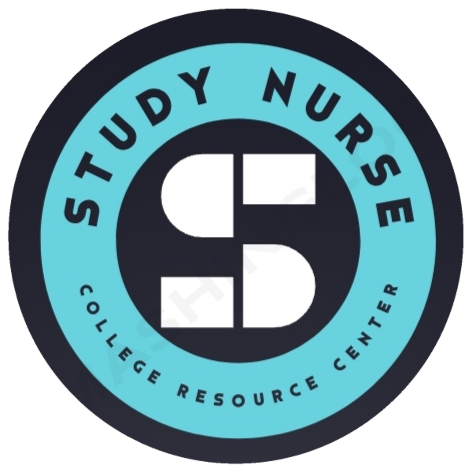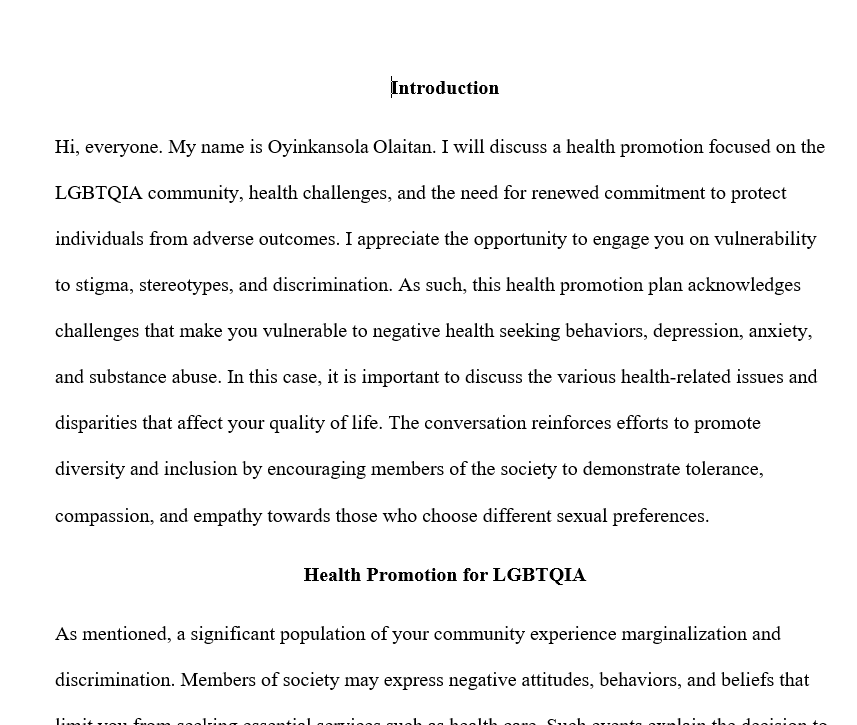Introduction
Hi, everyone. My name is Oyinkansola Olaitan. I will discuss a health promotion focused on the LGBTQIA community, health challenges, and the need for renewed commitment to protect individuals from adverse outcomes. I appreciate the opportunity to engage you on vulnerability to stigma, stereotypes, and discrimination. As such, this health promotion plan acknowledges challenges that make you vulnerable to negative health seeking behaviors, depression, anxiety, and substance abuse. In this case, it is important to discuss the various health-related issues and disparities that affect your quality of life. The conversation reinforces efforts to promote diversity and inclusion by encouraging members of the society to demonstrate tolerance, compassion, and empathy towards those who choose different sexual preferences.
Health Promotion for LGBTQIA
As mentioned, a significant population of your community experience marginalization and discrimination. Members of society may express negative attitudes, behaviors, and beliefs that limit you from seeking essential services such as health care. Such events explain the decision to remain invisible. The invisibility trigger delayed treatment, disproportionate access to STIs prevention measures, and reluctance to engage mental health and substance abuse counselors. Thus, this health promotion plan encourages you to come out and utilize resources within and outside the community to enable you access health services. Further, the plan advocates for tolerance, empathy, and compassion towards those who prefer a different sexual orientation. The positive relations align with the need to protect members of your community from verbal, physical, emotional, and other forms of abuse. The primary consideration is the need for everyone to live a fulfilling life regardless of your sexual orientation and preferences.
Importance of the Health Promotion Plan
The health promotion plan responds to challenges you members face after coming out. The lack of inclusivity and diversity causes social exclusion and isolation that put pressure on individuals’ mental, physical, and emotional wellness. In this case, you are more vulnerable to depression and anxiety are common due to challenges in disclosing one’s identity or reluctance by society to accept your sexual preferences (Chernosky, 2018). The health challenges cause a majority to engage in substance abuse including tobacco smoking and alcoholism. Thus, this health promotion plan seeks to empower you through an educational session meant to encourage you to take charge of your health by utilizing resources such as screening, contraception, and mental health counseling available within and outside their community.
The LGBTQIA Community
For this promotion plan, the focus is on the LGBTQIA members from a low-income neighborhood in University Park, California. As mentioned, a section of your members faces social isolation, health disparities, and violence associated with cultural intolerance and the lack of empathy. I understand that a larger section of your community includes individuals between 15 and 25 years. The younger age makes the group vulnerable to declining resilience to continue embracing their preferred sexual orientation. Specifically, this plan addresses the harsh realities that affect you mentally, physically, and emotionally. Coming from a low-income community characterized by underemployment, it is necessary for health stakeholders to intervene by making resources such as counseling, screening, STIs prevention, and other essentials easily accessible.
Integrating Principles Of Social Justice In Community Health Interventions
Goals of Health Promotion
- By the end of the educational session, you will identify three social support groups and programs available within or outside their community. After two months, you will have opportunities to provide feedback on attainment of agreed-upon health goals. I encourage you to complete a short survey emailed to you with questions on social support available to enhance access to medical and other services. The feedback will provide a foundation for identifying improvements required to strengthen access to social support programs such as advocacy groups to reduce rejection, ease stigma, and overcome feelings of isolation.
- By the end of the educational session, you will identify four risk factors that expose you to adverse health decisions and choices. During the session, it is important that you identify risk factors. Equally, after a month, I will come back and check with you to discuss the progress made towards improving health and well-being. I encourage you to take few minutes to respond to a questionnaire emailed to you. The tool provides an opportunity to respond to question about vulnerabilities and effective strategies for overcoming risks.
- By the end of the educational session, you will be able to verbalize online counseling services available to help them manage anxiety, depression, and other mental health issues. I encourage you to respond to questions asked during the session that focus on identifying available counselling services. After a month, another session will allow you to raise hands to confirm familiarity with counselling services and accessibility to mental, emotional, and physical health support.
The goals describe the need for the LGBTQIA members to embrace positive values, attitudes, and behaviors that allow them to utilize different community resources. I assure you that you will gain the courage to collaborate with various healthcare professionals such as social workers and community health workers to discuss culturally appropriate interventions that align with your needs and expectations (Hafeez et al., 2017). In this case, it is important that you gain the confidence to seek services, including preventive measures and counseling that empower you to live fulfilling lives.
Further, the goals reveal the need for increased awareness resources available on online platforms where you can share experiences with like-minded groups without the fear of victimization (Pillay et al., 2022). The aim is to develop and sustain positive attitudes and behaviors that encourage you to engage others, and acquire information on healthy living. Similarly, the community has an opportunity to be part of social networks that help strengthen mental and emotional resilience.
Health Promotion Plan
The program involves education on STIs prevention, treatment, and social support available on online and offline platforms. As mentioned, your members may be at a higher risk of tobacco use, alcohol abuse, risky sexual behaviors, and social exclusion triggered by stigma. Topics on the various risks and tailored interventions motivate members to view life from a positive perspective, including focusing on their education and career development.
Successful outcomes will enhance awareness about services available for you within and outside the community level. Successful outcomes also include efforts required to protect yourselves from self-harming behaviors such as suicide or drug abuse (Chernosky, 2018). The plan also encourages cultural tolerance, intelligence, and competence to promote equitable access to essential health care services regardless of one’s sexual orientation or gender identity. As such, the broader society should understand your unique needs and initiate individual and collective commitment to creating a safe environment for everyone regardless of their sexual preferences.
Changing Aspects of the Session
The educational session seeks to create and maintain an interactive environment characterized by efforts to make everyone feel safe and willing to share experiences associated with their preferences. It is crucial for you to familiarize with the accomplishments of various personalities who came out to disclose their non-heterosexual identity. Similarly, safe space signs with stickers and posters create open conversations where you can share experiences and interventions required to strengthen resilience in a culturally diverse environment. Open-ended questions and materials that include appropriate and inclusive language with the right pronouns also make the educational sessions viable in encouraging healthier choices. As such, you have the opportunity to openly disclose your preferred pronouns without the fear of victimization.
Improvements in Outcomes
As mentioned, your community is vulnerable to stigma, discrimination, and social isolation. This health promotion plan reinforces resilience in seeking mental health and other healthcare services to help your members cope with depression, anxiety, and other conditions associated with a non-conventional sexual identity. This plan has the potential to promote individuals’ well-being, foster safe and affirming environment, and empower members to seek mental and sexual health services at the community level. Further, you can become part of social support groups within the community and online platforms to enable you access information and be part of a network of like-minded individuals.
Alignment of the Plan and Healthy People 2030
This plan aligns with Healthy People 2030 emphasis on the need for accurate and complete access to information about LGBTQIA experiences and social and health care support. The health promotion plan outlines interventions for engaging you community safely and respectfully. The plan also acknowledges the need for online and offline social support to discuss your needs openly and identify tailored interventions. The goal is to overcome bias, prejudices, and stereotypes that undermine your ability to live fulfilling lives. It is also vital to protect your community from mental health issues such as anxiety and depression or addiction to different drugs, which affects social and economic prosperity. A comprehensive promotion plan also accommodates your diverse needs including preventive, treatment, and social support services available to improve quality of life.
Evaluation Post-Session
This plan significantly aligns with Healthy People 2030 objectives on LGBTQIA health. However, revisions are necessary to better align the session with Healthy People 2030 objectives. First, I will describe the social, cultural, political, and economic contributions of LGBTQIA person in the past and present. For example, it is crucial to analyze roles played by LGBTQIA in shaping the nation’s art, music, or film industry. The second adjustment is capturing the history of LGBTQIA. I encourage you to access information on major developments in LGBTQ and history. This activity provides a fun and interactive experience to understand experiences of the community and contributions made over the years across the United States. For instance, I encourage you to learn about key events in the LGBTQIA civil rights movement, create signs regarding these events, and spread awareness in school and other settings. Similarly, appraising the thoughts of different LGBTQIA theorists is crucial to make you confident embracing your preferred sexual orientation. The process boosts confidence in coming out. The lessons provide an opportunity for you to learn more about individuals’ experiences, reflect on what it means to come out, and understand the impact of coming out on individuals and society as a whole. I hope that you gain the confidence to come out and be more comfortable embracing your sexual preferences.
Conclusion
The LGBTQIA community needs confidence, support, and safe environments to encourage them to seek preventive measures and counseling associated with HIV/AIDS, depression, anxiety, and other conditions. In this case, it is necessary to increase awareness about resources available at the community level and from online platforms. This plan engages you on flexible access to tailored interventions to enable individuals to make healthy choices and restore resilience to enable them live fulfilling lives. As such, the community can develop and sustain positive attitudes and behaviors that encourage everyone to engage peers, acquire information on healthy living, and strengthen mental and emotional resilience.
References
Chernosky, M. (2018). A peer-support mental health response training for LGBTQIA+ adolescents. Journal of Mental Health and Clinical Psychology, 2(4), 21–27. https://doi.org/10.29245/2578-2959/2018/4.1151
Hafeez, H., Zeshan, M., Tahir, M., Jahan, N., & Naveed, S. (2017). Health care disparities among lesbian, gay, bisexual, and transgender youth: A literature review. Cureus, 9(4), 1-7. https://www.ncbi.nlm.nih.gov/pmc/articles/PMC5478215/pdf/cureus-0009-00000001184.pdf
ODPHP. (2022). LGBT. Office of Disease Prevention and Health Promotion. https://health.gov/healthypeople/objectives-and-data/browse-objectives/lgbt
Pillay, S., & Ntetmen, J., & Nel, J. (2022). Queering global health: An urgent call for LGBT+ affirmative practices, Lancet Global Health, 10, 574-578. https://www.thelancet.com/action/showPdf?pii=S2214-109X%2822%2900001-8

